Menu

Did you know using smart irrigation can use less water and grow more crops? It’s true. By using 20-40% less water, you can boost crops by 20-50%. This shows how big the benefits are in using sustainable methods on the farm. My way of Eco-Agri is about keeping the soil healthy from the start to when it’s sent out. And using earth-friendly ways all along the food’s journey.
Sustainable farming is a mix of good for the planet, for people, and for making money. It’s all about keeping the soil and wildlife rich, and producing food in a smart way that doesn’t run out of resources. I turn to things like crop rotation and using natural fertilizers. This way, I make sure what I’m doing is kind to the earth.
Sustainable farm management focuses on all parts of food production in a way that’s kind to our planet. It aims to balance financial, environmental, and social factors for lasting farm success.
It reduces the need for chemicals, which is great for us and the environment. This method relies on things like organic farming and helpful bugs to keep crops healthy. Using organic compost and looking after the soil also helps cut down on harmful gases.
Sustainable farming can save money and energy. This is seen in places like Québec, with a big market for “certified organic” produce. By sticking to organic principles, farmers can also grow more food.
For people, farming this way boosts local economies and helps keep everyone healthy. It helps with fair trade, better health, and strong local communities.
In nature, sustainable farms are key for diverse plants and animals. They stop soil problems and keep water clean. This kind of farming is truly good for our planet.
So, choosing sustainable farming leads to stronger farming systems. While it may start slow, it pays off in the end. It boosts farm earnings, lessens harm to the environment, and makes our food better and our countryside more interesting.
It’s vital to understand eco-agriculture’s core to build a sustainable farm. This method sees the farm as part of a bigger natural world.
This includes using agroecology principles for farming. These methods, like not ploughing as much and changing crops, keep the soil healthy.
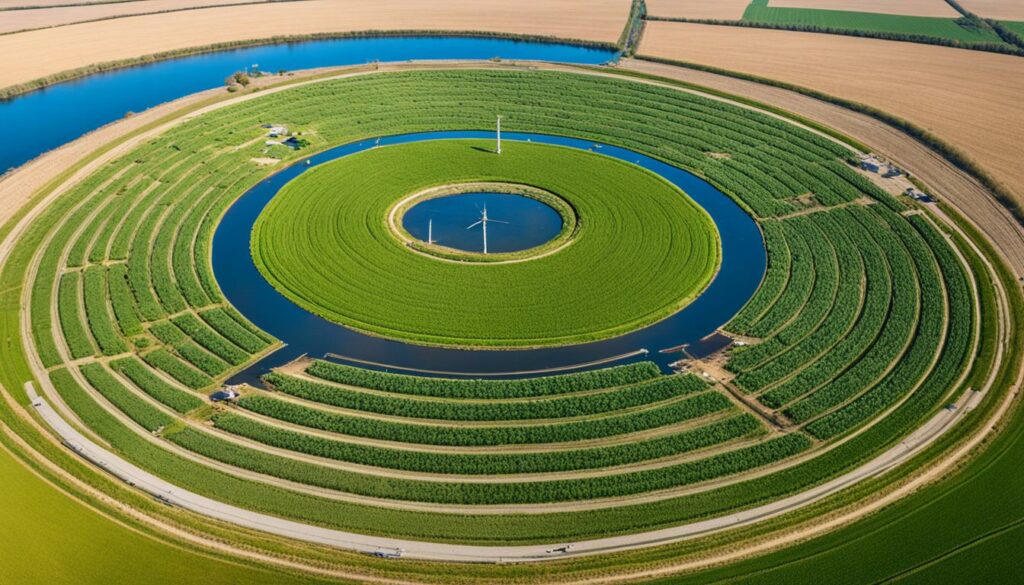
Energy should come from the sun and wind to be eco-friendly. This way, we use less energy that runs out and causes less harm to the planet.
Save water by using drip systems and collecting rain. This makes farms good for nature while still being productive.
To keep the land balanced, we need many different plants and places for animals to live. Agroforestry is when these methods work together. It’s good for the land and nature.
Farming should also be fair to people and help local communities. This means keeping workers safe and making sure people nearby have food.
Caring for animals correctly is key. They need clean water, good food, and a nice place to live. This shows we care for the environment in every way.
Eco-agriculture looks to the future while meeting our needs now. By following these ideas, farmers can make a strong, long-lasting way of farming. This is good for everyone.
By living these values, eco-farming can be both productive and good for the planet. This is how we secure a happy, healthy world for the future.
Crop rotation and intercropping are key parts of Eco-Agriculture for me. They help keep the soil healthy and increase farm output. These methods help create a balanced environment. This is key for the farm’s long-term resilience and success.
Crop rotation is great at reducing pests and breaking disease patterns. By planting different crops, I keep the soil’s nutrients in check. This way, all the nutrients the plants need stay available. It helps keep the land fertile without having to use a lot of chemicals.
I choose crops season by season, considering weather and market needs. This keeps the farm running smoothly. A well-thought-out rotation plan also makes sure we don’t wear out the land. It keeps our soil rich and our farm steady.
Growing different plants close together is what intercropping is all about. This method uses resources like light and water better. The result? Higher yields and more money. Also, it confuses pests, helping us use fewer chemicals.
Intercropping isn’t easy, but the good outweighs the bad. It needs careful management. Yet, it can improve soil health and lead to better crops.
Testing intercropping on small scales first is smart. It helps us see if it fits our farm well. We consider our farm’s unique features, like its soil type and climate. This makes the technique more likely to succeed.
Both crop rotation and intercropping are critical for me. They do a lot for the soil, fight pests, and help the farm stay strong. They are the heart of my farm’s long-lasting success.
Good soil health is key to farming that lasts. It’s vital to keep soil’s key traits through proper care. This includes making sure soil’s structure is good, organic matter is plentiful, and it’s a welcoming place for tiny life forms critical for plants and ecosystems.
Preventing soil loss from wind and water is a big task. Doing this has become harder with our farming and grazing. No-till and low-tillage farming help a lot. They stop erosion, lower soil hardness, and make homes for wildlife and helpful bugs. They add lots of carbon to the soil near the top. But be careful, turning the soil just once can quickly use up much of that carbon.
Cover crops bring many good things. They help keep soil in place, stop nutrients from washing away, fight off weeds, up soil nutrients, and make space for lots of different life. They work best in places with lots of rain in the winter. Here, they make the rain soak in slower, keep soil from splashing away, let water get deep into the ground, and help keep the underground water well topped up. Farmers like to use beans and peas in their cover crops. These plants grab nitrogen from the air and slowly give it back to the ground when they break down.
| Practice | Benefits |
|---|---|
| No-Till/Strip-Till |
|
| Cover Crops |
|
| Conservation Cover |
|
| Contour Buffer Strips |
|
Using many different cover crops adds a lot of life to a farm. It makes sure the area does different jobs for nature. Planting cover crops in the spaces between main crops does even more good. Enabling long-lasting plants to grow together helps keep soil rich and gives bugs a great place to live. It works well with regular farming, too.
Using these ways to care for the soil makes a big difference. It helps keep the land productive and healthy for a long time. Taking good care of the soil now means we can keep farming well for many more years.
Water conservation is key for sustainable farming. Around the world, nearly seven billion people use huge amounts of water. This water is needed for farming, making things, and for our cities. In the future, we may need 40% more water than we have now. It’s vital to use water wisely to meet both agricultural and city needs.
Drip irrigation saves water effectively in farming. It sends water right to the roots of plants. This way, there’s less waste and the crops get just the right amount of water. With drip irrigation, water evaporation and runoff are reduced. The result is a greener farming approach that makes better use of water and harms the environment less.

Rainwater harvesting is crucial for green farming. It captures rain for plants. This method works well in places where rain is unpredictable. It helps save costs and lessens the pressure on rivers and lakes. With rainwater harvesting, the environment wins too.
The Murray-Darling Basin Balanced Water Fund, worth AU$27 million, is a great example. It supports water markets to help farmers, communities, and nature. The fund aims to grow to AU$100 million. This will have a bigger positive effect on the environment and society. It’s working towards better water use in a vital Australian farming area.
Boosting biodiversity on the farm is key to maintaining our planet’s health. It helps keep the environment in balance. Fields that are more diverse offer homes and food to insects and animals. They also help the farm work better.
Plants that grow back every year are important. They mean we can use less nitrogen, which is good for the water and the creatures that live in it. Having many different plant types helps farming stay strong in changing conditions. This supports nature.
Using smart ways to farm supports the Earth and keeps businesses going. Looking after the land like it’s one big system helps nature thrive. It also respects different people’s ways of life. All this makes sure everyone works together for a bio-diverse farm.
Helping save nature involves different plans for each place. By working closely with nature groups, farms can get more help from governments. This makes saving wildlife worldwide even better. Having clear goals and dreams is crucial for these groups.
Protecting nature should be a forever thing. It needs us to keep caring and keep hoping for real changes. A lot of land is used for crops and animals. We must use this land smartly to keep nature healthy.
People have had a big impact on the Earth, like making too much nitrogen. This has hurt places such as the Gulf of Mexico. We must be careful with our actions to keep nature’s balance right.
Farmers with more land and money can often sell their crops for a good price. This lets them choose a wide variety of plants to grow. Yet, small farmers need help to do the same. Making rules that are fair for everyone helps.
Big farms that sell lots need help too. They could sell different crops if rules help them do so. All farmers, big and small, should help protect the Earth. This way, farming can be both a business and a way to care for the world.
Integrated Pest Management (IPM) is key to eco-friendly land care. It looks to cut down the harm of pest control on nature. IPM uses many methods to keep crops healthy and lower the use of chemicals. It focuses on natural ways to manage pests, which is vital for lasting farming.
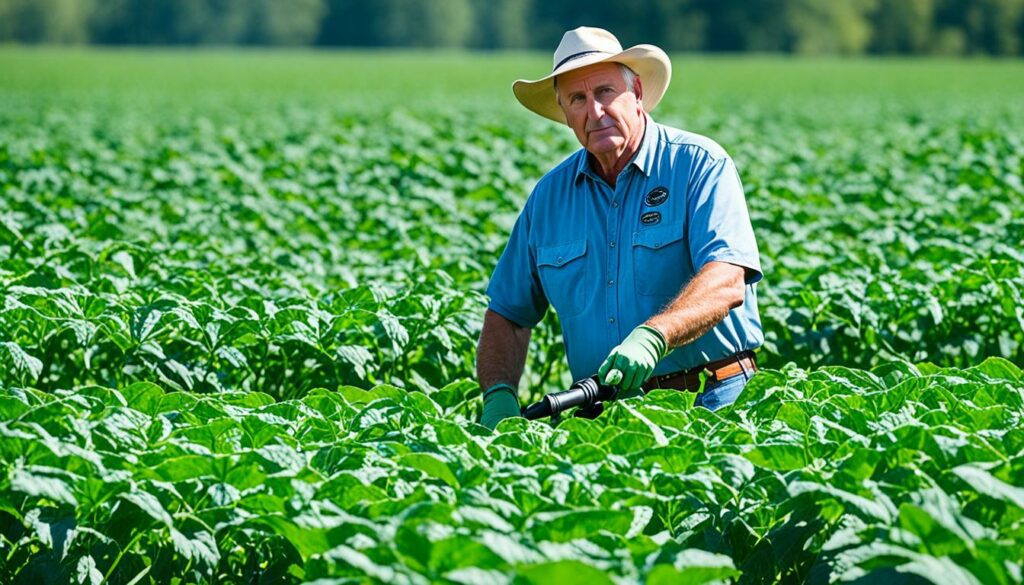
In IPM, cultural controls change the farm to stop pests from spreading. This includes switching crops and planting kinds that pests don’t like. Farming changes create an unfriendly place for pests. This reduces their impact without using pesticides. This method is good for the ecosystem and farming that lasts.
Using nature’s own checks and balances is a big part of IPM. It means using natural predators and helpers to control pests. This way is better than using chemicals. It helps keep nature in balance.
| Element | Description | Benefits |
|---|---|---|
| Prevention | Using things like crop rotation and resistant plants to stop pests from taking over. | This lowers the number of pests and cuts down on chemicals. |
| Monitoring | Checking how many pests there are often. This helps to know when to act. | It makes pest control more effective and on time. |
| Cultural Controls | Changing farming methods to not attract pests. This makes the farm healthier. | It helps in lasting farming and less chemical use. |
| Biological Controls | Using natural enemies and products from nature to fight pests. | This way protects the environment and balances the ecosystem. |
Farmers can make their farms more sustainable by using IPM. The UC IPM Program helps with steps for over 65 crops. It aims to use less pesticide while keeping crops healthy.
Farming needs green energy for a sustainable future. It’s vital to use clean energy sources to cut costs and protect the planet. This also ensures farming can continue for a long time.
Solar energy is very useful for farms, lowering electricity costs a lot. Thanks to the Investment Tax Credit, farmers can save up to 30% on installing solar panels. This makes solar power even more affordable.
In areas with a lot of wind, wind power is a good choice. It helps make farms more self-sufficient and can even make them money by selling extra electricity. Both solar and wind power get help from the Rural Energy for America Program (REAP). This program can cover half the costs.
Biogas systems change waste into energy, cutting landfill waste and fossil fuel use. Using these systems boosts a farm’s energy efficiency. State programs and federal initiatives, like EQIP, support making farms more energy efficient. They provide grants and help with audits.
Here’s a look at what different green energy systems offer and the help they can get:
| Energy Source | Benefits | Incentives |
|---|---|---|
| Solar Power | Reduces electricity bills significantly | Investment Tax Credit (up to 30%) |
| Wind Energy | Stores or sells excess electricity back to the grid | Rural Energy for America Program (up to 50% of costs) |
| Biogas Systems | Converts waste to a renewable energy source | Agriculture Energy Efficiency Rebate Program, Environmental Quality Incentives Program |
So, combining solar, wind, and biogas energy changes the way farms use energy. With help from government programs, going green is both smart for the environment and for a farm’s finances.
Sustainable livestock management is key to keeping farms productive yet eco-friendly. Livestock make up 40% of what we get from farming. They’re also crucial for the lives and food of 1.3 billion people. So, ethical land use is very important.
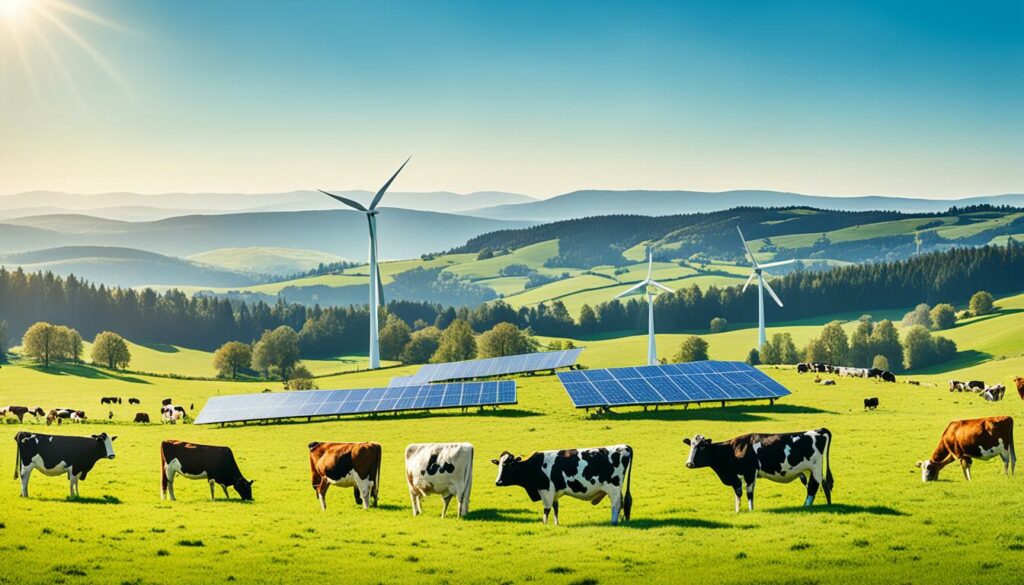
Treating livestock properly is crucial. This includes giving them plenty of clean water, good food, and a safe place to live. Taking care of animals in the right way leads to less illness. This means we can use fewer drugs and make safer food.
Using natural feed and forage is also key to sustainability. It’s important for the animals and the environment. Feeding livestock naturally cuts down on harmful gas. It also helps with waste and means farming has a smaller impact on nature.
This kind of farming is good for both the land and the people who depend on it. It gives farmers a better life and a fair share of resources. Plus, by breeding animals carefully and feeding them well, we can make farming more efficient. This means needing less land and less water, which is good for the planet.
Choosing sustainable ways for livestock helps everyone. It keeps animals happy, the earth healthy, and the farming business strong.
Agroforestry combines trees with farming and is a key part of sustainable land management. It makes farms diverse and helps the environment while making farms more profitable.
In California today, farms are mostly growing one type of crop. But, this method needs a lot of chemicals to keep going. Switching to agroforestry can help by using less chemicals and balancing nature.
One helpful agroforestry method is alley cropping. It adds trees between crop rows, which helps use water better and keeps the soil healthy. Trees also make farming spaces cooler, cleaner, and better for bug control.
Agroforestry comes in many forms, like windbreaks and combining farming with forestry. These methods make farms stronger, more sustainable, and able to earn more money.
There’s a lot of support for agroforestry. The NRCS, FSA, and SARE offer help and funding for farmers to start. These programmes support the valuable work of agroforestry.
If a farmer wants to try agroforestry, there are many places to get advice and help. The USDA and organizations like the Association for Temperate Agroforestry are good places to start. They provide useful tools and information for farmers to grow better.
In sustainable farming, it is vital to use resources wisely and have different ways to make money. This helps farms stay financially strong and protect the environment.
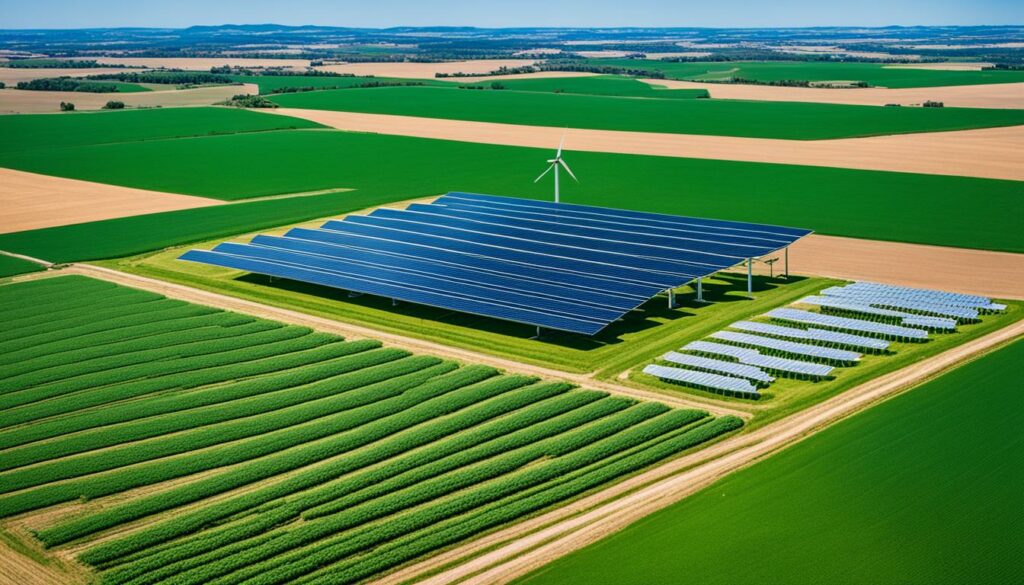
Using resources efficiently is key to making sustainable farming work. For example, no-till farming and drip irrigation save water and soil. They make crops grow better and save energy, providing both economic and environmental benefits.
Having different sources of farm income is important for economic safety. Value-added products, like organic goods, help farms find new customers. This stabilises the local economy and food supply.
| Practice | Benefits |
|---|---|
| No-till Farming | Prevents soil erosion, reduces fossil fuel emissions |
| Smart Irrigation | 20-40% less water usage, 20-50% increase in crop yield |
| Renewable Energy | Lower dependency on fossil fuels, cost savings |
| Agroforestry | Enhances biodiversity, adds new revenue streams |
By using these strategies, sustainable farms can be financially strong. They also help meet ecological and community needs, showing the power of resilient farming.
Bringing social equity in agriculture to the forefront is key. It lets us build farming systems that include everyone in a sustainable way. Working with local people on farming projects boosts the community’s power. This way, not only the environment benefits but also everyone involved can thrive.
Urban farming shows what community empowerment can do. In the United States, about 13% of people lack reliable access to food. Urban farming efforts change this by making fresh, healthy food more available. Also, growing your own food in community gardens can save you money on groceries.
These activities also lift our spirits and keep us healthy. Being outdoors and working out in community gardens are good for us. They also bring people together and make our community stronger. This brightens everyone’s life and helps keep our areas safe.
But, to make urban farming work, we need everyone in the community to join in. Without their support, plans can go wrong. It’s also vital to make sure the ground and food are safe from any harmful substances.
“Diverse perspectives in agriculture systems lead to improved sustainability outcomes and foster innovation tailored to social-ecological contexts.”
Getting better at social equity in agriculture calls for giving people the power and ensuring fair policies. We need to listen to and involve the local community in decisions. This way, the benefits of good farming spread fairly. Sharing our goals, work, and challenges makes more people want to help.
| Benefits of Urban Agriculture | Impact on Communities |
|---|---|
| Improved food and nutrition security | Enhances access to fresh, nutritious foods |
| Cost savings on groceries | Makes healthy foods more affordable |
| Physical and mental health benefits | Encourages physical activity and reduces stress |
| Increased community cohesion | Fosters social connections and strengthens social capital |
| Perception of neighbourhood safety | Contributes to crime reduction and a safer environment |
To truly achieve social fairness in farming, we must keep learning and improving. By making sure everyone can take part and using fair rules, we spread the benefits. This way, the whole community and the world around us get better.
Sustainable farm management is all about being productive without harming the environment. It means agricultural work helps the planet and grows plenty of food. We use tricks like keeping soil healthy, saving water, and using clean power to make farming strong and green.
To keep farms productive and eco-friendly, we need smart methods. These methods make the soil better, use less water, and cut non-renewable energy use. By doing things like changing which crops we grow, covering the soil, and not digging it too much, we keep the land healthy for years.
We also use smart ways to water plants, like putting water right where it’s needed. This saves a lot of water. Farms of the future will mostly use the sun and wind for power, which is better for the planet.
To make farming last a long time, we have to think of everything. This means controlling pests in ways that don’t hurt nature, keeping waste in check, and making space for many different plants and animals. These careful ways of farming help grow food without making the earth sick.
Planting local plants is good for stopping pests and helping useful bugs. This makes the farm more balanced and kind to all creatures. In the end, the right farming methods look after people, animals, and the whole ecosystem.
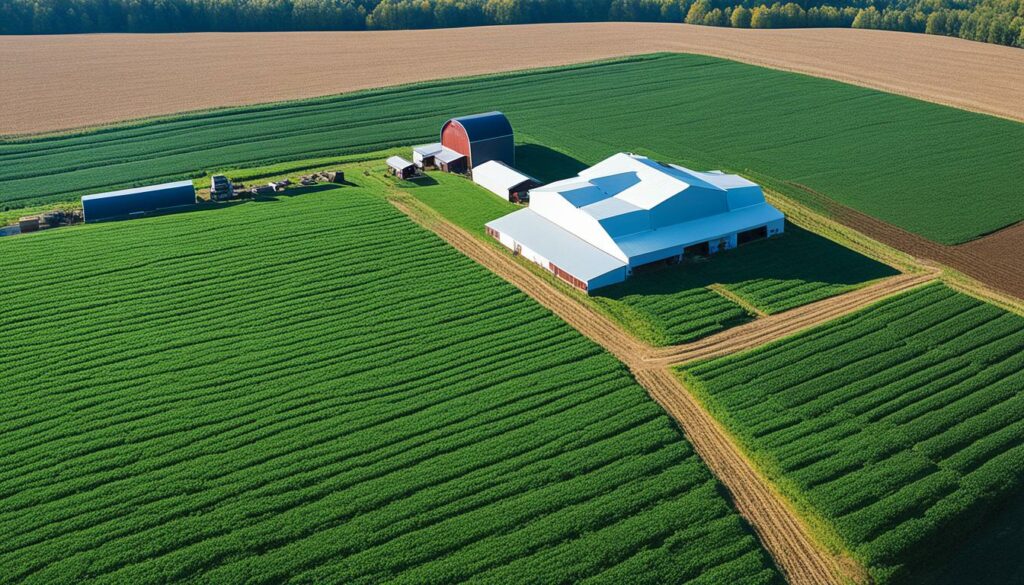
| Technique | Benefit |
|---|---|
| Crop Rotation | Improves soil health and breaks disease cycles |
| Drip Irrigation | Reduces water waste and improves efficiency |
| Renewable Energy | Decreases reliance on non-renewable sources |
| Integrated Pest Management | Minimises chemical pesticide use |
| Native Planting | Supports biodiversity and natural pest control |
Sustainable farm management uses eco-friendly ways to blend ethical, economic, and ecological principles. This approach is crucial for sustainable agriculture development. It not only promotes green strategies but also helps us to feed a growing world.
To keep the land healthy, farmers use techniques such as crop rotation and cover cropping. They also save water through drip irrigation and by collecting rainwater. Adding trees to farms helps with diversity, soil health, and economic strength.
Stopping the breakdown of forests is key, together with defending untouched areas. This helps fight climate change by lowering greenhouse gases and keeping carbon safe. In the end, these efforts show a path to a better tomorrow for all.
Sustainable Farm Management is about using practices that support our earth. It includes techniques from regenerative agriculture and holistic farming. The goal is to keep our soil healthy, increase biodiversity, and use fewer man-made products. This way, our farms can last for a long time.
Sustainability in farming helps keep our planet healthy for the future. It keeps our environment clean, supports our economy, and makes sure people are well off. By using methods like organic farming and protecting our farms, we create a strong and lasting way to grow food.
Eco-Agriculture sees farming as part of the bigger picture. It includes saving energy, being fair to people, and using methods like agroforestry. These are ways to keep our lands, plants, and animals healthy together.
Crop rotation helps a lot. It stops pests from getting too comfortable and makes the soil better. Diseases are less likely, and plants use food from the ground in a more efficient way. This means more and healthier food can be grown.
Intercropping is about planting different crops together. It makes the best use of space and helps the soil. It also lowers the risk of pests. By doing this, the farm becomes stronger and greener.
Soil health is very important for sustainable farming. Ways to keep soil healthy, like not tilling too much and planting cover crops, mean we’re caring for the earth properly. These actions add to the life in the soil and means we don’t need so many man-made things.
Supporting effective water use, sustainable farms might use less and find ways to collect rainwater. Drip irrigation and rainwater harvesting save water and money. This is a good way to look after our resources well.
A mix of crops and keeping natural spaces on farms is good for everyone. It helps plants and animals live well together. This way, it’s easier to keep the farm free of pests and the land fertile without using chemicals.
IPM is about managing pests without just using chemicals. It changes the environment so pests aren’t as happy. Using the bugs that eat the bad bugs is another way. This is better for the land and the people who work on it.
Farms benefit from green energy like solar power and using farm waste for fuel. These ways of producing energy mean we don’t use up things that harm the earth. They also make the farm more independent and efficient.
Looking after animals well is key. It’s about giving them clean water, safe food, and a good place to live. Feeding them naturally and not using harmful substances helps the whole farm stay balanced and healthy.
Agroforestry combines trees with the things we grow and the animals we raise. It makes for better soil and more kinds of plants and animals. It’s a smart way to use the land that gives the farm more ways to thrive.
Farms improve by using all their resources well, looking at new ways to make money, and not wasting things. By selling what they produce in smart ways, they help their communities and look after the earth better.
Letting local people be part of the farming decisions is very important. It makes sure everyone gets treated fairly and feels part of the community. This makes the whole system work better and makes the land and people healthier and happier.
Long-lasting farming cares for the soil, manages water well, and uses clean energy. It’s about protecting life on the farm and in the area. These ways lead to a farm that can grow food for many generations to come.